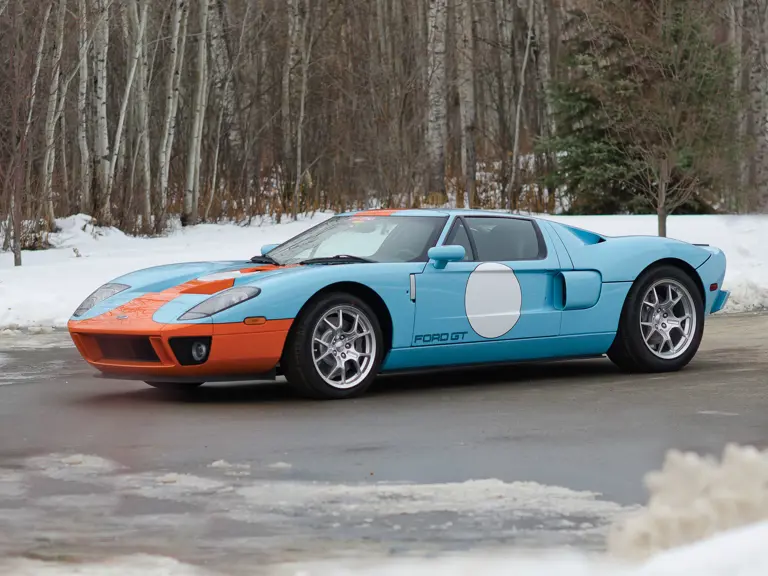It could be argued that one of the most contentious racing rivalries in the history of motorsport was the Ford-Ferrari rivalry in the mid-1960s, and it all started with a possible merger. Enzo Ferrari approached Ford Motor Company in early 1963 looking to sell the road-car division of his company and Ford was very receptive, thinking that this partnership would bring them increased sales in the showroom and victories on the track. However, upon seeing the final version of the contract, Enzo believed that he was not given enough freedom or control with the racing section of the new company and refused to sign, leaving himself in charge of the company that bore his name and keeping Ford out of Maranello.
Furious, Henry Ford II wanted retribution for this colossal deal gone awry. He wanted to hit Mr. Ferrari where it hurt: on the race track. Ford put his own engineers to work, hired new personnel and the GT 40 was born with the goal of defeating Ferrari at the 24 Hours of Le Mans. Mr. Ford got his retaliation, and the GT 40 stunned the world with its performance at the 1966 24 Hours of Le Mans, where three examples swept the victory rostrum, led by Bruce McLaren and Chris Amon. Nineteen sixty-five would be the last year Ferrari won overall at Le Mans, and the GT 40 would go unbeaten through 1969.
Following the GT 90 concept of 1995, Ford unveiled the GT in 2002, to celebrate the Blue Oval’s upcoming centennial, and left no doubt as to its dazzling heritage. Inspired by the all-conquering GT 40 racecars that beat Ferrari at Le Mans and won the famed 24-hour race four years in a row, the new GT was much more than a mere design resemblance. It was a supercar the likes of which Detroit had never before produced, capable of lightning-fast sprints of 0- to 60-mph in well under four seconds, yet tremendously competent in every other discipline; cornering and braking included. On top speed alone, it surpassed even the Porsche Carrera GT and Mercedes-McLaren SLR. It was even setting new lap records on the Nürburgring’s Nordschleife, faster than many of the highly-developed cars from Porsche.
The iconic blue and orange livery was worn by the cars of the John Wyer racing teams of the 1960s and ‘70s and is one of the most widely respected and recognized in the world of motorsports. Back-to-back wins at the 24 Hours of Le Mans in 1968 (driven by Pedro Rodriguez and Lucien Bianchi) and 1969 (with Jackie Ickx and Jackie Oliver), contributed mightily to the reputation of both the car and the Englishman Wyer; he was known as “Death Ray” for his famous glare, his impeccably run team, and was a force in international racing for decades managing the factory teams for Aston Martin, Ford and Porsche.
In 2006 Ford added a special limited-edition ‘Heritage’ paint scheme to the exclusive GT that recalled that famous JW Automotive/Gulf Oil livery of the Le Mans-winning GT 40, the “Heritage Edition” Ford GT. This striking machine is finished in Heritage Blue with Epic Orange stripes and White roundels. This pristine example has not received any designated number. When new, this was a $13,000 option, explaining why only 17-percent of GT production was finished as such. Only 343 Ford GT’s received the Heritage Blue paint scheme, this car represents number 122 of this select group.
Power comes from a supercharged 5.4-liter dual overhead cam V-8 producing 550 brake horsepower and projects a throaty and muscular exhaust note. This is matched with a Ricardo six-speed manual transaxle featuring a helical limited-slip differential. The engine also has a dry-sump oil system. The brakes are four-piston aluminum Brembo calipers with cross-drilled and vented rotors at all four corners. With great visual effect, when the rear canopy is opened, the rear suspension components and engine are evident and impressive.
Featuring space-age construction technologies, the GT was produced in four distinct stages, with initial assembly at Norwalk, Ohio’s Mayflower Vehicle Systems, paint by Saleen at the Saleen Special Vehicles facility in Troy, Michigan, engine assembly at Ford’s Romeo, Michigan engine plant, followed by engine and transmission installation, plus interior finishing, at Ford’s Wixom, Michigan plant. Interestingly, the Ford GT was the last vehicle project at Wixom.
Standing only 44.25-inches in height, the Ford GT features many distinctive technologies, including formed frame, aluminum body panels, roll-bonded floor panels, a friction stir welded center tunnel, a "ship-in-a-bottle" gas tank, a cap-less fuel filler system, one-piece door panels and an aluminum engine cover with a one-piece carbon-fiber inner panel. Standard safety equipment includes frontal airbags, antilock brakes and a tire inflation kit in lieu of a spare tire.
Of the 4,500 GTs originally planned, approximately 100 were to be exported to Europe, starting in late 2005. An additional 200 were destined for sale in Canada, such as this car. Production ended in 2006 without reaching the planned build number the final tally was registered as 4,038 total cars built over the 2004 to 2006 period. The GT being offered is reported as car number 778 of the 2,011 built in this model year.
According to sources, the Canadian-spec GT’s all came with the optional forged wheels, gray brake calipers and the regular stereo; there was no “stripe delete” option with the Heritage Edition either. The lack of offering the McIntosh CD stereo system on Canadian examples is attributed to reducing weight gains from the car’s different bumper configuration. Being a Canadian car, it does have daytime running lights, a different type of heavier foam in the front bumper, and a small foam insert in the rear bumper makes it protrude slightly further than it U.S.-spec counterpart.
With flawless execution of ownership from its beginning and only 2.7 miles driven, this remarkable Ford GT remains as new and creates the opportunity for driving sensations that need to be experienced to be appreciated in full. The Ford GT is still on its Manufacture State of Origin (MSO) and came well-appointed from the factory with air conditioning, tilt/telescopic steering wheel, CD player, rear window defogger, rain-sensing wipers, front and rear spoilers; power windows, mirrors and door locks. The sale includes all factory documents and the accessories which were generously provided when new. This may be the lowest mileage Heritage, let alone modern Ford GT that exists.
When introduced, demand outstripped supply, with early cars selling for substantial premiums over the MSRP. No doubt, this would have brought delight to Henry Ford II, Enzo Ferrari’s arch-rival during the 1960s, the Ford GT remains more than capable of running with its period competition from Maranello. With its performance credentials, quality of manufacture, and its clear lineage to the original GT, it is obvious that Ford created a modern classic.



 | Fort Lauderdale, Florida
| Fort Lauderdale, Florida


